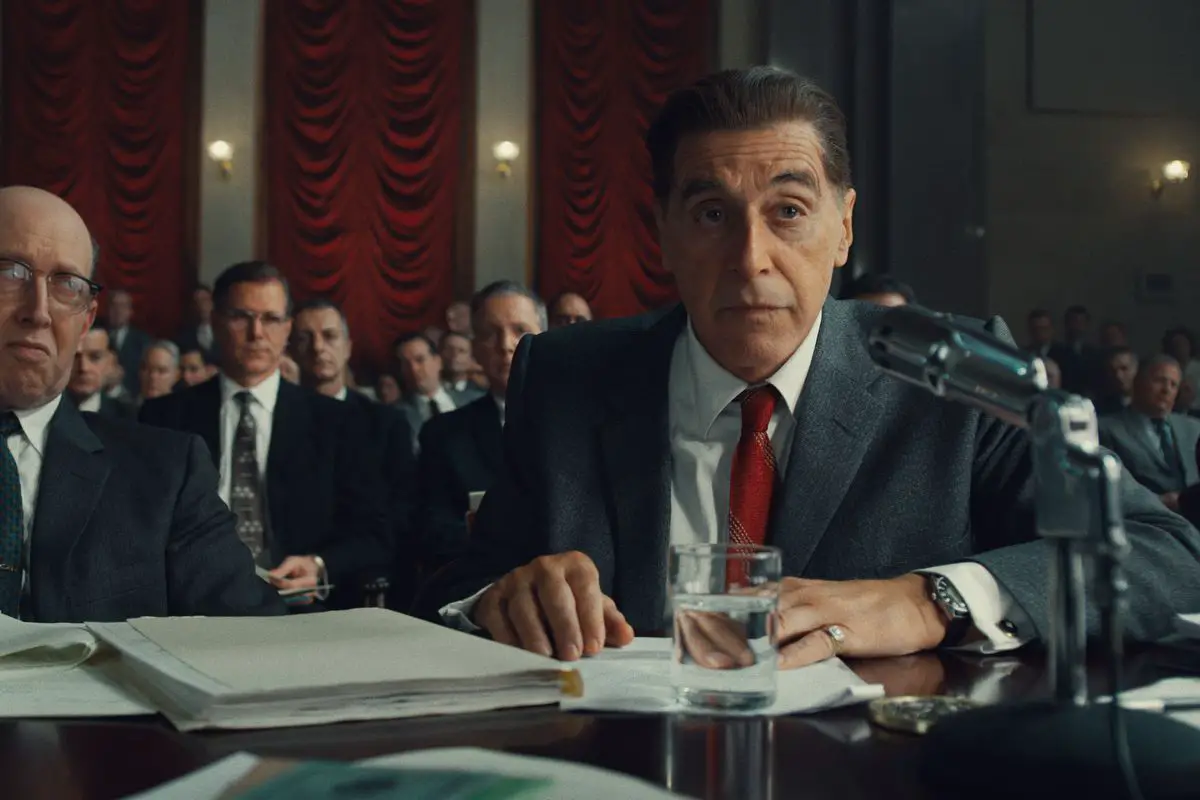Things accumulate pretty quickly across a 209-minute runtime — gestures, phrases, routines. “The Irishman,” Martin Scorsese’s latest film, uses repetition to express the feelings hidden by tortuous obliqueness and machismo. The repeated rituals are also part of a larger goal to express the intimate humanity of people who saw themselves as larger than life or part of something bigger. By using strategies like this throughout the story, Scorsese is able to expand upon the emotional resonance of the film.
The story is relayed to us through Frank Sheeran, played by Robert De Niro, a man who embodies the stoic mafia ideal. Although “The Irishman” is ostensibly a no-holds-barred story of his life, the film quickly complicates the tidiness of a typical biopic; accompanied by Frank’s voiceover and The Five Satin’s “In The Still of the Night,” the camera crawls unsteadily through a nursing home to find Frank himself, where he completes the voiceover’s train of thought with his own spoken dialogue. This shift is not a smooth transition. Rather, it gives the effect of an old man aimlessly speaking to himself. It’s the first in a long series of techniques meant to de-romanticize and muddle Frank’s retelling of his life.
“The Irishman” displays many narrative and stylistic similarities to the stories told in “Goodfellas” and “The Wolf of Wall Street,” but Scorsese sets his newest film apart in numerous unmissable ways.
Criticism has been brought against the de-aging effects used in the film, but the effectiveness of the smoothed out faces lies in how it adds another layer of distance between the film and Frank’s perspective. However, not every effect is so subtle: On-screen text often turns the most peripheral characters into reminders of the stark realities of mafia life. Each distancing effect ultimately links back to the indifference of time; the film’s second scene doesn’t juxtapose an old Frank with a young Frank. Instead, the first part of the story presents Frank as a middle-aged gangster living out a banal existence. “The Irishman” is not just a filmmaker examining the way his own style works with real crime stories. The film underscores its theme by making the slight changes to the styles established in “Goodfellas” and “The Wolf of Wall Street” feel like a natural evolution of Scorsese’s earlier works.
In the film’s first flashback, “The Irishman” also establishes Frank’s closest mafia tie, Russ, played by Joe Pesci, as a man stuck on inconsequential and arbitrary rules. The men of the film frequently have conspicuous quirks or insecurities, and almost everyone feels like a manifestation of the rigid toughness required by their lives of crime. As the mob rules and personal philosophies are revealed to be hollow, they both are revealed as sad, ineffectual bids at self-preservation. The mob rules initially feel like slick workarounds for the law, but the crimes and workarounds never change.
Throwing guns into moving water is how Frank covers up his hits for the mob, and the no-nonsense approach to covering tracks is cleverly realized through a montage of different guns going into the water; however, an older Frank isn’t afforded the same sense of cool. The repetition of post-crime procedure loses any and all sense of glamor as crime becomes mundane.
Their idiosyncrasies are also proof of an insuppressible humanity the characters either can’t locate or communicate. The strictness of the three leads’ lifestyles leave them largely unaware of their quirks. “The Irishman” finds tragedy in the way people are discouraged from the things making them human.
#TheIrishman wins best picture from the New York Film Critics Circle https://t.co/jDmxfmJ6D2 #NYFCC pic.twitter.com/5pEQUgoQ8G
— Variety (@Variety) December 4, 2019
Russ is nothing like the roles for which Pesci is best known through “Home Alone,” “My Cousin Vinny” and “Goodfellas.” Russ is made out to be a calm, loyal figure who believes in the irrefutable worth of personal connection. His first meeting with Frank exists outside of anything crime-related, and the friendship begins when Frank and Russ bond over a shared knowledge and affection for Italian culture. The friendship is quickly characterized as an acknowledged weakness by Russ — a distinction that makes his sincerity feel loaded.
Pesci’s “Funny How?” improvisation in “Goodfellas” sought to establish how aggressive mercuriality is excused by power, but Pesci’s performance in “The Irishman” builds up the normalization of cruelty by making the mob’s actions feel like a natural reaction to anyone who might not get the rules. Russ’s calmness is disquieting in its total assuredness and understanding of the mafia’s needs; there’s no need for violent hysterics when the system he helped build is so impermeable.
Al Pacino as Jimmy Hoffa is the inverse of everything Pesci brings to the film. His own assuredness is expressed through bravado and a dedication to his own arbitrary rules. Pacino often communicates with his hands, but his character’s words are more declarative responses than conversation. In the few moments where Pacino makes extended eye contact, there is a tangible sense of condescension or denial. The ability to make Hoffa’s cocksureness come across as equal parts endearing and annoying is a testament to Pacino’s skill. He is among the film’s most human characters; Hoffa wants to be someone whose personal rules are respected, but the circumstances corrupting the purity of his persona make his independence impossible.
Thank you #NYFCC!
Best Film – THE IRISHMAN
Best Supporting Actor – Joe Pesci pic.twitter.com/XKfvv4Si3r— Netflix Tudum (@NetflixTudum) December 4, 2019
Among the greatest strengths of “The Irishman” is how Hoffa and Russ are characterized by their relationship with Frank. De Niro plays Frank with a shockingly limited emotional range. The beginning of the film shows how Frank is completely cold-blooded, but the rest of the film challenges him to find a way to express his wants and needs. De Niro’s face is in a near constant state of careful consideration and quiet conflict; this restraint makes his brief moments of insuppressible sadness or gratitude all the more resounding.
While Hoffa’s reactions work to reinforce his own stance, Frank’s response is in the way he tries to find the quickest middle ground. His sense of duty drives him, but loyalties become muddled as personal affection and professional efficiency butt heads. Frank is only able to express himself through the actions he’s willing to perform for others. When his blankness is pointed out, he expresses his gratitude in the only way he knows how: “I’m on it. I don’t know what to say, but I’m on it.” The same loss for words makes the film’s final third almost oppressively heartbreaking.
“The Irishman” is still weighing on me as heavily as it did when the credits rolled. In Edward Yang’s film “Yi Yi,” two characters discuss how seeking out films is like allowing yourself additional lives. Few films have embodied that belief more than this film, as “The Irishman” has the effect of letting you experience lives lived, forgotten and lost. The three leads are only a few pieces in the film’s overall effect, and the connections across the runtime feel endless. It’s the most affecting film I’ve seen this year, and I couldn’t recommend it any more highly.
















